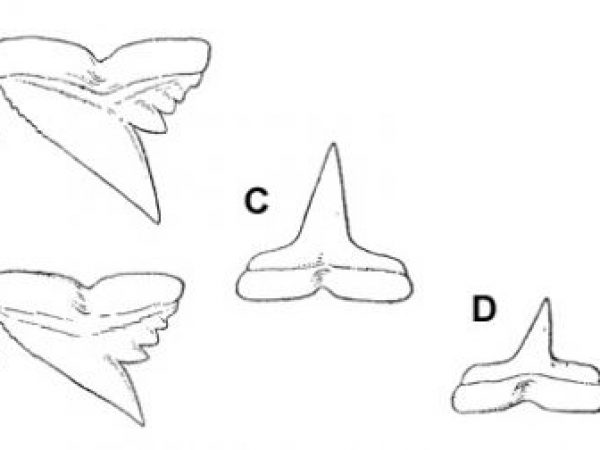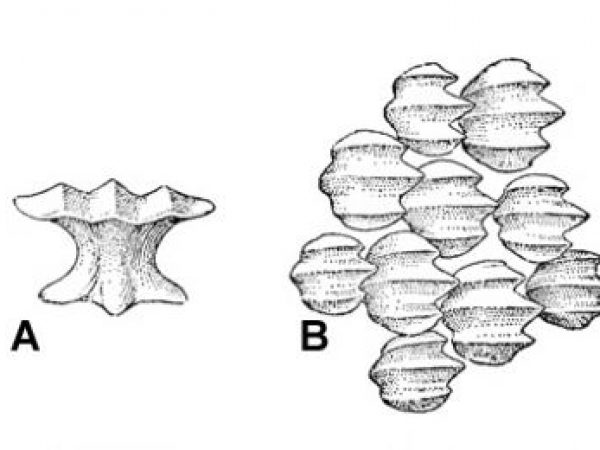Night Shark
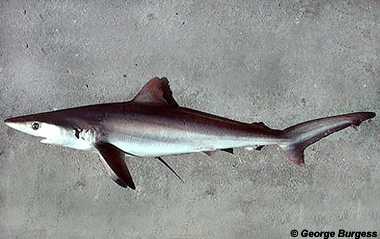
Carcharhinus signatus
This slender, medium sized, gray-blue shark is often mistaken for similar species. It has a long, pointed nose, and a somewhat small dorsal fin, but has a typical requiem shark body and coloring. Because of its diel vertical migration, it has the large eyes suited to live at depths during the day and come up closer to the surface at night to feed.
Order – Carcharhiniformes
Family – Carcharhinidae
Genus – Carcharhinus
Species – signatus
Common Names
The common name of C. signatus in the United States is the night shark, due to its capture most often at night (Bigelow & Schroeder). Some common names from other countries include nachthaai (Dutch), requiem de nuit (French), requin de nuit (French), tiburon de noche (Spanish), tiburon nocturno (Spanish), tubarao-da-noite (Portugese), nachthai (German).
Importance to Humans
While initially only retained as by-catch from billfish and tuna fishing trips, the night shark is now beginning to be commercially targeted off the northeast coast of Brazil for its fins and meat.
Danger to Humans
According to the International Shark Attack File, there are no recorded attacks on humans by the night shark. The risk of attack on humans by the night shark is decreased due to its deep water habitat and nocturnal activity.
Conservation
> Check the status of the night shark at the IUCN website.
The IUCN is a global union of states, governmental agencies, and non-governmental organizations in a partnership that assesses the conservation status of species.
Geographical Distribution
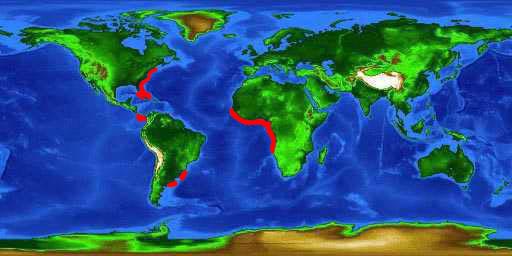
Night sharks have been found in the Atlantic Ocean from Argentina to Delaware (USA) and along the west coast of Africa. This shark is also seen in the Gulf of Mexico and off the coast of southern Brazil.
Habitat
The night shark is typically found near outer continental shelves of subtropical waters in depths between 900 feet (275 m) and 1200 feet (365 m) during the day, and 610 feet (185 m) at night.
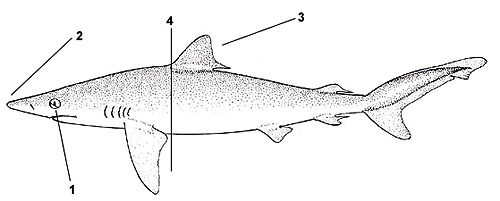
Distinguishing Characteristics
1. Eyes are large and green
2. Snout is long and pointed
3. The first dorsal fin is small
4. The first dorsal fin originates over or behind free tips of pectoral fins
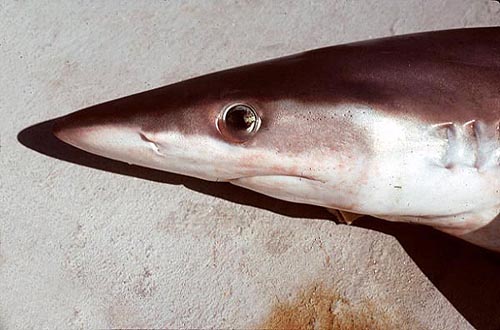
Biology
Distinctive Features
The night shark is distinguished by a very long, pointed snout that is longer than the width of its mouth. It also has large green eyes when alive and a relatively small first dorsal fin that originates behind the free rear tips of the pectoral fins. The second dorsal fin is also small and low, originating just above the origin of the anal fin. A low interdorsal ridge is present between the first and second dorsal fins. The moderately long pectoral fins are slightly sickle-shaped with narrowly rounded ends.
Similar species include the silky shark (C. falciformis) and the dusky shark (C. obscurus), however both of these sharks lack green eyes when alive. The silky shark also has a more rounded and swept back first dorsal fin. Another species similar in appearance to the night shark is the spinner shark (C. brevipinna). The spinner shark can be distinguished from the night shark by the absence of the interdorsal ridge.
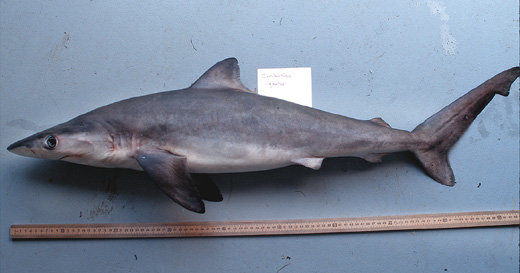
Coloration
The coloration of the night shark is grayish blue and gray-brown above, with a white to gray-white underbelly. Occasionally, small black spots can be found distributed around the body or a subtle white band over the flank. Embryos are blue or silvery gray above with a grayish white underbelly.
Dentition
The night shark has 15 rows of teeth on each side of the upper and lower jaws. The upper symphysis has one or two rows of small, triangular teeth, while the lower symphysis only has one row of the same type of teeth. The upper jaw is filled with teeth that have increasingly oblique cusps, meaning the angle of curvature of the teeth increases as they progress from the middle of the jaw toward the corners of the mouth. The upper teeth also have a noticeable indentation on the outer margins. Each upper tooth has between two and five coarse serrations from the notch to the base of the tooth. The lower jaw has symmetrical, narrow, and erect teeth.
Denticles
The skin of the night shark is composed of dermal denticles that are loosely spaced and overlap minimally. There are typically 3 low ridges on each denticle.
 Night shark dentition A. Sixth upper tooth; B. Twelfth upper tooth; C. Fourth lower tooth; D. Eleventh lower tooth. Image courtesy Bigelow and Schroeder (1948) FNWA
Night shark dentition A. Sixth upper tooth; B. Twelfth upper tooth; C. Fourth lower tooth; D. Eleventh lower tooth. Image courtesy Bigelow and Schroeder (1948) FNWA Night shark denticles A. Apical view of dermal denticle (60x); B. Dermal denticles (30x). Image courtesy Bigelow and Schroeder (1948) FNWA
Night shark denticles A. Apical view of dermal denticle (60x); B. Dermal denticles (30x). Image courtesy Bigelow and Schroeder (1948) FNWA
Size, Age, and Growth
The night shark grows to a maximum total length (TL) of 9 feet (2.8 m), with an average size of 6.5-8 feet (2.0-2.5 m). The maximum published weight of this shark is 169 pounds (76.7 kg).
Food Habits
The night shark typically feeds on squid and small bony fishes, including flyingfish, scombrids, butterfishes, and sea basses.
Reproduction
The night shark reproduces viviparously with a yolk sac placenta. Between 12 and 18 pups are born in each litter, with an average length of approximately 2.2 feet (68-70 cm) at birth. Males reach sexual maturity between 6.0 and 6.2 feet (1.85-1.90 m) TL, while the females are slightly larger at sexual maturity with a length between 6.5 and 6.7 feet (approximately 2.0 m).
Predators
Larger sharks are potential predators of night sharks.
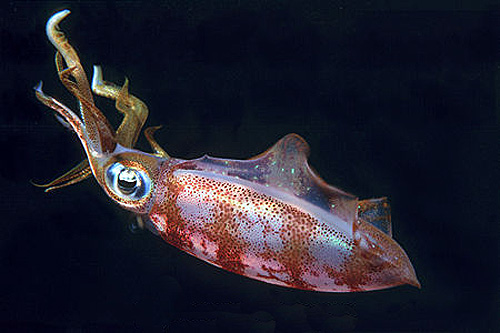
Parasites
The copepod Kroyeria caseyi sp.nov. (Kroyeriidae: Siphonostomatoida) has been described from the gills of night sharks in the western North Atlantic. Another copepod, Pandarus smithii, has been documented as a parasite on the body surface of night sharks.
Taxonomy
The original combination of genus and species for Carcharhinus signatus was Hypoprion signatus, named by Poey in 1868. The original genus of Hypoprion comes from the Greek root words of “hypo” meaning “under” and “prion” meaning “saw”. The valid genus of Carcharhinus comes from the Greek root words of “karcharos” meaning “sharpen” and “rhinos” meaning “nose”. Synonyms of C. signatus include H. longirostris Poey 1876 and H. bigelowi Cednat 1956.
Prepared by: Kate Barzan
